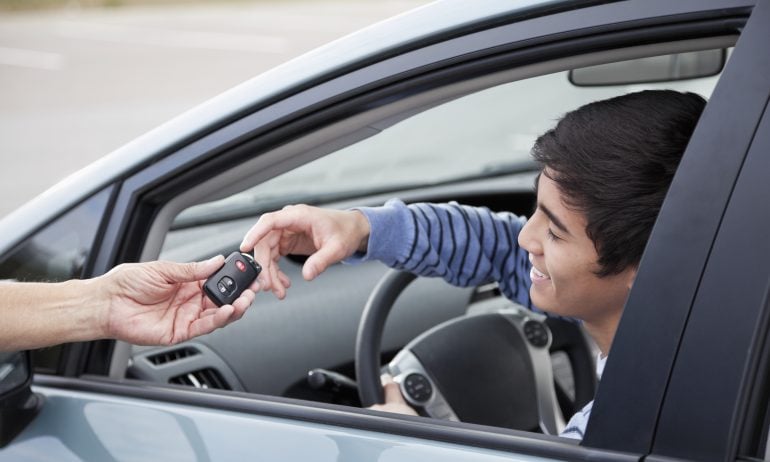How to Buy a Used Car
Tools like pricing guides, online listings and vehicle history reports can simplify your used-car shopping experience.

Many, or all, of the products featured on this page are from our advertising partners who compensate us when you take certain actions on our website or click to take an action on their website. However, this does not influence our evaluations. Our opinions are our own. Here is a list of our partners and here's how we make money.
Buying a used car instead of a new one can save you money on car insurance, registration, taxes and depreciation (which is the loss in a car’s value due to wear and tear over time).
But in the current used-car market — where supply is somewhat limited — it might be difficult to find exactly what you’re looking for at the price you want. However, there are tools and tips for buying a used car that can help you find a pre-owned vehicle that meets your needs and fits your budget.
Our used-car-buying guide covers the process — from setting a budget to making the purchase — whether you buy from a dealer, a private-party seller or an online retailer.
Explore the auto-buying platforms from our partners below.
AD
1. Determine how much to spend
When buying a used car, you can pay cash or take out a loan. If you’re paying with cash, try not to spend all your savings, and remember to set aside money for registration, insurance and possible future repairs.
Most people take out a car loan so that they can protect their savings or buy a more expensive model. When financing, the first step to take is to get preapproved for a loan, which can simplify the buying process and put you in a stronger position at the dealership.
To determine how much you can afford to put down and pay monthly, use an auto loan calculator to run the numbers on payments and term lengths. Aim to put down about 10% of the purchase price, which helps decrease the amount you’ll need to finance. Additionally, if you can, budget so that your monthly auto expenses — such as car payment, gas and insurance — won't be more than 20% of your monthly take-home pay.
Also, consider the total cost of ownership. Some cars may be cheaper upfront, but the costs can add up in the long run because of insurance, maintenance, repairs and depreciation.
Find your preapproval rates
Auto loans from our partners

on Auto Credit Express
Auto Credit Express

N/A
525
on Auto Credit Express
» MORE: Compare the best car loan rates today
2. Create a used car must-have list
Selecting the right car can be overwhelming, but it can help to start with a list of what's most important to you. Take time to think about how you plan to use the car and what features would make one a good fit.
For example, if you have a family, you might prefer an SUV with more passenger and cargo space than you would have in a sedan. If you want to reduce gas expenses as well as your carbon footprint, an electric vehicle or hybrid could be the better choice.
Safety ratings are another aspect to consider. If safety is a top priority for you, check out a car model's safety features and crash test ratings through the Insurance Institute for Highway Safety.
Also, you will want to make sure you're choosing models known for their dependability. While you might have a maximum mileage in mind, some models are known for continuing to perform well beyond 100,000 miles, depending on how well they've been maintained. You can find auto reliability ratings online from J.D. Power and Consumer Reports.
As you move forward, build a list of a few car models to research in more detail.
3. Find used cars in your budget
To narrow the field, search for specific used vehicles that meet your must-have criteria. You'll find many websites that list used cars for sale, some with car-buying apps to make shopping on your phone easier.
Consider these online car-buying retailers and marketplaces:
Online marketplaces, such as Autolist, Autotrader and Used Car Search Pro, aggregate listings from online retailers, dealerships and sometimes individuals from across the country. Once you find a listing you like, they’ll give you the seller’s contact information.
Traditional private-party sales platforms, such as Craigslist and Facebook Marketplace, are popular shopping platforms if you’re looking to buy a used vehicle from a private seller. Individual sellers are often looking to make a quick sale, so it’s possible to get a great deal — but be careful about scammers.
Most used car lots have the cars in their inventory posted online as well. However, if you’re someone who prefers seeing the car in-person, you can always start with visiting dealerships.
Something else to consider is whether you want to pay a little more to buy a certified pre-owned vehicle. CPO cars have been thoroughly inspected, reconditioned with factory parts and include an extended factory warranty. While they're pricier, they're also considered to be more reliable.
4. Check your car’s price
Once you find viable car options for sale — but before you physically inspect them — look up that car model in a pricing guide such as Kelley Blue Book, Edmunds and the National Automobile Dealers Association. You can use these guides to estimate the market value of the actual car you’re looking at by assessing its condition based on factors such as age, mileage and options. Knowing the current market value of the car you’re interested in can help you negotiate the car's price more effectively when it’s time to buy.
Most pricing guides give you several different prices. If you're buying the car from a dealer, look at the “dealer retail” price. If your next-door neighbor is the seller, you should look at the “private party” price. You might also notice that pricing guides tell you what the car is worth as a trade-in. Make sure to price your current car if you plan to trade it in at the dealership.
It’s important to read the descriptions of the condition levels carefully. Each pricing guide has its own rating methodology for determining the difference between “clean” and “outstanding,” for example.
5. Get a vehicle history report
Vehicle history reports give buyers information about a car’s past, including title information, any major accidents, past owners, mileage and more. Some reports also show if required maintenance was done on time and where the work was performed
In some cases, online car listings will include access to free vehicle history reports. Plus, most dealers have subscriptions to vehicle history report services and typically provide them for free. If you’re unable to get a free report, you can buy an individual one or a subscription for a limited time from a trusted provider like Carfax or AutoCheck.
Note that while vehicle reports can give you a quick glimpse into a car’s past, they don’t tell you everything you need to know about how reliable a car will be. Even after viewing a report, you should still see a car in person to determine if you should seriously consider buying it or not.
6. Contact the seller
After you find a car you’re interested in pursuing, contact the seller to see if the vehicle is still available and to ask specific questions about it – especially if you’re buying from an independent seller.
If you’re buying from a private-party seller, it’s important to ask the following questions:
Are you the first owner?
Are the service records available?
Do you have the title and is it clear? (A clear title shows there are no liens on the car.)
How did you set the asking price?
Is there any important information that wasn’t in the ad?
Can I have the car inspected by a mechanic?
7. Test-drive the car
Car shoppers should always test-drive a car before buying if possible, because it can alert you to any potential problems a vehicle might have. It also allows you to give the car an initial visual inspection before taking it to a mechanic.
Keep the following in mind while test-driving:
When you start the car, all the warning lights should turn on for a few seconds, then go out. Be sure to check lights for the four most important car parts: engine, oil pressure, brakes and airbag. Select a test-drive route that has a little bit of everything: hills, rough pavement, curves and even a stretch of highway.
Check for visibility, particularly if there are any blind spots, how the car accelerates and stops, if the brakes are responsive and predictable, how driving it feels. Also, check for mechanical condition: Listen for any unusual noises or vibrations that could indicate worn suspension parts or tires.
Test things like the back-seat legroom and cargo capacity, the sound system, and any other features that are important to you.
8. Get a car inspection from a mechanic
If you liked driving the car and it seems to be in good condition, you should still take it to a mechanic. Used car inspections can cost between $100 to $300, depending on the mechanic. Both private sellers and dealers should allow such inspections. If a seller pushes back, claiming they’ve already inspected it, that might be a sign that they are untrustworthy. The one exception is if you buy a certified pre-owned vehicle.
Buying from an online auto retailer can be challenging, since you may not be able to test-drive or inspect a car before buying it. But, you typically have a certain amount of time in which you can return the car, so it's important to drive it a lot and get an inspection before the return window expires.
9. Negotiate the best price
Negotiating with a seller may seem daunting, but if you are prepared and have a good idea of what the car is worth, it can be easier. These tips can help you while you negotiate:
Compare the seller’s asking price to the average market price you determined on the pricing guides and negotiate from there.
When you bargain with a car salesperson at a car lot or dealership, remember that you're dealing with a pro who knows all the tricks.
Don’t be a monthly payment buyer. If you have a preapproved loan, you're a cash buyer as far as the dealer is concerned and you should negotiate on the price of the car, not the size of the monthly payment.
Make an offer that is on the low side, but still enticing. Then, improve your offer slowly, in small increments.
Negotiate slowly and repeat the numbers you hear. Take your time to understand all the numbers being thrown at you. Write them down, if that helps you. Confirm if you're talking about the “out-the-door” price, which includes all taxes and fees, or just the sale price of the car.
Ask about fees before saying yes to a deal. Some dealers include bogus fees to take back profit they lose during the negotiation. Get a breakdown of additional fees before you agree to any deal.
Always be ready to walk. If you aren’t making progress toward a deal, or you don’t like the way you’re being treated, just walk out. You don’t need an excuse. “I’m not going to buy” is good enough.
10. Make the purchase
Before taking ownership of the car, you should add it to your auto insurance policy. Then, you only need to pay for the car — usually with cash or a cashier’s check. Make sure you get a title and have the seller sign it correctly. (If the seller’s name isn't on the title, you could be a victim of title jumping, which is illegal.) When in doubt, check the state’s registry website for more information. Title transfers must happen within 10, 15 or 30 days depending on the state.
If you're buying from a private party, and there is still a loan on the car, call the lender to find out how to close the deal. If the lender is a bank, offer to meet the seller in a branch office and sign papers there.
If you’re at a dealer, even if you have a preapproved loan to pay for the car, the dealership’s finance manager will probably offer to beat the terms of the loan. It doesn’t hurt to see if they can get a better interest rate. In such cases, remember to check that all the other terms of the loan are the same.
Before the contract is drawn up, the finance manager will also likely pitch you additional products and services. Buying an extended warranty at the right price can provide peace of mind — but first check how much warranty still remains on the car.
Once you sign the sales contract, the car is yours. Take your time reviewing the contract and don’t let yourself be pressured into signing just to get it over with. The contract will include the agreed-on sales price and additional items like state sales tax, documentation fee and registration fees.
Dealerships may try to add on extra fees, which are sometimes unnecessary. Ask the finance manager to explain any fees in the contract. If they can’t, ask them to remove the fees.










